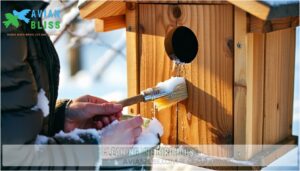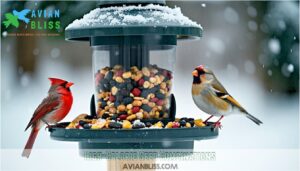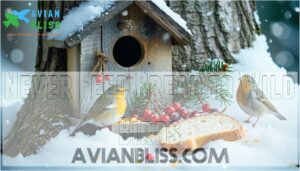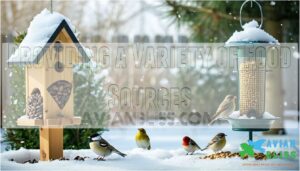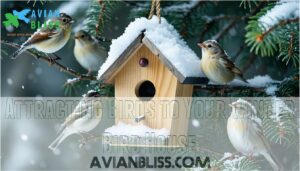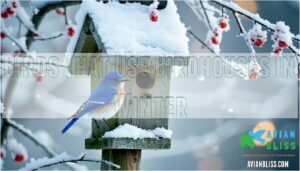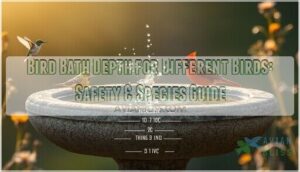This site is supported by our readers. We may earn a commission, at no cost to you, if you purchase through links.
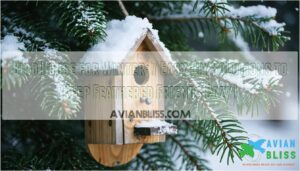 A bird house for winter can be a cozy retreat for feathered friends facing freezing temperatures.
A bird house for winter can be a cozy retreat for feathered friends facing freezing temperatures.
To make it winter-ready, choose a sturdy wooden design with thick walls for insulation. Add a small door to keep drafts out and consider a rough interior surface to help birds grip.
Position the house in a sheltered spot, away from strong winds or predators, and clean it thoroughly before use.
Insulating with wood chips or straw adds warmth, while small perches help birds huddle together. Curious which birds will move in or how to keep the water ice-free? You’re in for some fun discoveries!
Table Of Contents
- Key Takeaways
- Providing Shelter for Winter Birds
- Winter Bird House Maintenance
- Essential Winter Bird Feeding Tips
- The Importance of Water for Winter Birds
- Attracting Birds to Your Winter Bird House
- Birds That Use Birdhouses in Winter
- Winterizing Your Bird House
- Frequently Asked Questions (FAQs)
- Will birds use birdhouses in winter?
- What is the best birdhouse for winter?
- What is the best thing to put out for birds in the winter?
- Do birds need shelter in the winter?
- Is it okay to paint a birdhouse?
- When should you clean out birdhouses?
- What direction should a birdhouse face?
- What color do birds hate?
- How do you prepare a birdhouse for winter?
- Do cardinals use birdhouses in the winter?
- Conclusion
Key Takeaways
- Provide insulation with materials like straw or wood shavings, and block drafts to keep the birdhouse warm and safe.
- Position the birdhouse away from harsh winds and predators, ideally facing east or southeast to catch morning sunlight.
- Regularly clean the birdhouse by removing old nests and debris to prevent parasites and create a healthy space.
- Offer high-calorie foods like suet or sunflower seeds and ensure access to fresh or heated water to support birds through winter.
Providing Shelter for Winter Birds
You’ll help your backyard birds survive harsh winter conditions by providing shelter that protects them from freezing temperatures and predators.
Providing safe, warm shelters ensures winter birds thrive, shielding them from harsh elements and predators while offering a cozy haven to conserve heat.
A properly positioned winter birdhouse creates a vital haven where small birds can conserve body heat through communal roosting, making the difference between survival and death during the coldest nights, which is crucial for their survival in harsh winter conditions, and provides them with a safe place to conserve body heat.
Winter Bird House Assembly
Setting up your winter bird house is easier than you think with the right approach.
Let’s break down this DIY bird house project:
- Gather essential assembly tools: hammer, screws, drill, and measuring tape
- Choose quality materials like cedar or pine for durability
- Follow step-by-step guides for proper construction
- Make design modifications for winter protection
- Apply safety precautions when using tools
Select weather-resistant materials and make certain your construction provides proper shelter from harsh elements—your feathered neighbors will thank you for the proper shelter
Winter Roosting Box Plans With Perches
With your birdhouse structure complete, it’s time to create winter roosting boxes with proper perch placement.
Use 3/8-inch wooden dowels for perches, staggered at different heights to encourage communal roosting. Cedar makes an excellent perch material, offering durability against winter elements.
Consider that bluebirds prefer perches for easy access. Install 5+ perches (3 inches long) to accommodate multiple birds huddling together.
For box convertibility, design a front panel that rotates to transform your winter bird shelter into a spring nesting box.
Bird House Design Tips
Designing a winter bird house? Think about material choice—wood’s natural warmth works best.
Keep the entrance size snug (1 1/2" prevents larger, unwanted guests).
Add insulation methods like sawdust for cozy vibes and make certain perch placement inside for huddling.
Shape considerations also matter; avoid drafts by lowering the hole.
Following simple bird house plans creates the perfect insulated birdhouse for winter birds.
Why Do Birds Use Birdhouses in Winter
Cold weather birds rely on winter birdhouses for warmth and protection.
Winter birdhouses provide essential warmth and safety, shielding birds from the cold and predators during harsh winter nights.
These shelters offer five essential benefits:
- Winter survival by shielding birds from freezing temperatures.
- Predator protection to keep them safe from threats like cats and hawks.
- Roosting benefits, ensuring group warmth during frigid nights.
- Energy conservation by minimizing exposure to harsh winds.
- Species shelter suited to their nesting habits.
By setting up a cozy winter bird shelter, you’ll provide a safe haven where feathered friends can rest, stay warm, and thrive all season long.
Why Don’t Birds Use Your Birdhouse in Winter
Sometimes, your winter bird house mightn’t attract visitors due to common issues.
Birds prioritize safety, so pay attention to these factors:
- Location: A spot exposed to predators or harsh elements can deter cold weather birds.
- Design Flaws: Small sizes or drafty holes make winter bird shelters uninviting.
- Uncleanliness: Dirty roosts discourage picky birds.
- Late Setup: Birds scout winter shelters early, missing yours if it’s too late.
Winter Bird House Maintenance
Keeping your birdhouse in top shape during winter makes a big difference for your feathered visitors.
Regular cleaning, repairs, and insulation help create a safe, warm space that protects them from the season’s harsh conditions.
Cleaning The Birdhouse
Give your birdhouse a fresh start this winter with routine birdhouse cleaning! Regular cleaning frequency prevents parasites and keeps birds healthy.
Start by removing old nests to stop infestations and eliminate disease risks. Use safe cleaners like mild soap and water—no harsh chemicals.
Scrub all surfaces thoroughly to guarantee proper birdhouse sanitation. While you’re at it, inspect for cracks or damage to guarantee birds feel secure.
Handy tools like brushes and gloves make the work easier. Routine birdhouse maintenance preserves your birdhouse and also helps create a cozy, welcoming home that every feathered guest will appreciate!
Insulating The Birdhouse
Keeping your birdhouse warm isn’t tricky—think of it as adding a cozy sweater.
Start with natural insulation materials like straw, pine needles, or wood shavings. Block any excess ventilation to retain heat while allowing safe airflow.
Many builders choose sustainable building materials for their projects. Thick wooden walls (at least 3/4 inch) boost warmth retention in your winter bird house.
For extra comfort, consider adding a bird house heater for those frosty nights. Your feathered friends will thank you!
Repairing Damage
Inspect your birdhouse thoroughly for damage like wood rot, cracks, or loose panels. Fixing these guarantees better structural integrity and keeps drafts out.
Use wood glue, screws, or new bird house materials for repairs. Consider purchasing specialized repair components for your birdhouse.
Prioritize leak prevention and predator damage shielding. A well-maintained birdhouse feels like home!
- Seal cracks to block chilly winds.
- Patch holes to prevent water leaks.
- Reinforce edges for sturdiness.
- Replace rotting wood to guarantee safety.
Placing The Birdhouse in a Safe Location
When placing your bird house, location is everything for keeping your feathered friends safe and warm.
- Predator Deterrence: Mount the birdhouse on a metal pole or high tree to prevent predator access.
- Wind Protection: Face the entrance away from harsh winds for a cozy roost.
- Sunlight Exposure: Position it to catch afternoon sunlight for extra warmth.
- Mounting Height: Install at least 10 feet up for reliable bird protection and shelter.
Essential Winter Bird Feeding Tips
Cold weather challenges birds to find enough food to survive, so it’s up to you to help them out.
By offering high-energy seeds, suet, and a variety of natural food sources, you’ll keep them fed and active all winter long.
High-Caloric Seed Combinations
For birds braving winter, a high-calorie buffet is essential.
Black oil sunflower seeds shine with their superior Seed Energy Content and thin shells, making them a favorite across feeders.
Bulk up your offerings with Seed Mix Ratios, including white millet for ground feeders and nyjer for finches.
Affordable seed options like cracked corn add variety.
To attract a wider array of species, consider regional seed options.
Smart winter bird care means filling your bird feeder winter-style to support birds’ Winter Calorie Needs!
Suet and Fresh Seeds
Winter bird feeding becomes a joy when you combine suet and fresh seeds for your feathered guests.
Suet is a high-energy treat, perfect for cold days. Keep feeders stocked with a seed variety to attract specifics like finches or chickadees.
Follow these quick tips:
- Experiment with suet types.
- Feed often to prevent spoilage.
- Choose sheltered feeder spots.
- Check daily for freshness.
Never Feed Bread to Wild Birds
Feeding wild birds bread may seem kind, but it’s not—bread’s nutritional value is nearly zero for them.
It can harm digestion and cause issues like "angel wing" in waterfowl, plus, leftover scraps harm the environment.
Instead, focus on alternative foods like seeds, suet, or fruit to keep birds healthy during winter bird feeding.
By providing proper food around your winter bird house, you’re not just feeding them—you’re protecting birds this winter, responsible feeding guarantees a safe, cozy bird shelter in every frosty yard corner.
Providing a Variety of Food Sources
It’s no secret—birds thrive on variety! Skip the bread and offer a spread that supports winter bird survival. Mix high-caloric seed combinations with suet for energy. Think black oil sunflower seeds or peanuts.
To maximize the benefits:
- Use multiple bird feeders: Offer diverse foods like millet, nyjer, and cracked corn for different species.
- Prevent waste: Rotate feeders and clean them often to keep food fresh.
- Mimic natural foraging: Scatter seeds near shrubs or under trees for a lasting impact.
Combine consistent feeding frequency with proper placement, and your backyard stays bird-friendly all winter.
The Importance of Water for Winter Birds
Don’t forget that birds need fresh water just as much as food during winter, especially when natural sources freeze over.
Providing a consistent water source can help birds stay hydrated and maintain their feathers for insulation against the cold.
Heated Bird Baths for Winter
Don’t let icy winters leave your feathered friends thirsty! A heated bird bath is a simple way to support them when water sources freeze.
With thermostatically controlled heaters, these baths guarantee safe, ice-free spots for hydration while using minimal energy. Birds depend on reliable water for drinking and bathing, keeping their feathers in top shape for warmth and flight.
Supplying birds with a consistent water source is vital during freezing temperatures.
- Benefits of a heated bird bath:
- Keeps water consistently ice-free, even in freezing weather.
- Reduces energy use with efficient heating methods.
- Guarantees bath safety by avoiding slippery ice layers.
Your yard becomes their cozy, life-saving retreat!
Fresh Water Sources for Drinking and Bathing
When temperatures plummet, providing a fresh water source becomes as important as food.
Heated bird baths prevent freezing, ensuring access to drinking and bathing benefits. Carefully consider water source placement—sunny spots help maintain water temperature.
Add a bird bath heater for consistent warmth or try natural de-icing methods. Your yard becomes a lifesaver for birds craving an ice-free solution, providing them with a much-needed fresh water source.
Keeping a Bird Bath Ice-Free
A fresh water source in winter is like a luxury spa for birds, giving them what they need to thrive.
To keep your bird bath ice-free, try these strategies:
- Use a heated bird bath or a simple bird bath heater for hassle-free warmth.
- Place the bath in a sunny spot—solar birdbaths work wonders!
- Experiment with DIY de-icers like warm stones or shallow dishes to slow freezing.
Protecting birds in winter starts with offering drinkable water, supporting their winter roosts and health.
To further prevent freezing, consider the benefits of insulation.
Attracting Birds to Your Winter Bird House
If you want birds to visit your winter bird house, make it as inviting as possible by offering clean water and nearby sheltering plants.
A safe, cozy environment can help birds find the warmth and security they need during colder months, which can be enhanced by a cozy setup.
Offering a Clean Water Source
A clean water source is essential in winter, as birds need unfrozen water to stay hydrated.
Place a heated bird bath or use a bird bath heater for non-freezing solutions.
Choose sturdy water source materials, refresh water daily, and check cleaning frequency.
Ensuring bird bath safety—like avoiding slippery edges—helps birds access hydration comfortably while beautifying your backyard.
Creating a Bird-Friendly Environment
To attract winter birds, create a safe haven they’ll adore.
Focus on predator protection and comfort with thoughtful roost placement and proper bird house insulation.
Enhance the area by:
- Using safe materials for construction and maintenance.
- Ensuring water availability with nearby heated baths.
- Planting trees or shrubs that provide natural food sources.
Your efforts help birds feel secure while protecting them during harsh weather—making your winter roosts a true sanctuary for feathered friends.
Native Plants and Naturalized Areas
Think of native plants as a natural shelterbelt for birds, offering food and protection in tough weather.
Grow goldenrod for an insect habitat, winterberry for winter berries, coneflower for seed dispersal, or hawthorn for cozy cover.
These plants help with bird house winterization by providing natural insulation nearby, making your winter roosts part of a haven for protecting birds all season.
Birds That Use Birdhouses in Winter
You’ll be surprised how many birds seek shelter in birdhouses during the winter to escape the cold and predators.
Species like chickadees, wrens, and bluebirds find these cozy spaces essential for survival when the temperature drops.
Tits and Chickadees
Tits and chickadees brighten winter with their social hierarchy and lively antics.
Support their survival by protecting birds in winter with properly placed birdhouses.
Here’s how to help:
- Secure Shelters: Winterize bird boxes to shield them from cold temperatures.
- Nutritious Meals: Their winter diet favors seeds and suet.
- Chickadee Roosting: Encourage group huddling.
- Cavity Competition: Make space for these cavity-nesting songbirds.
Ducks and Wrens
When preparing your winter birdhouse plans for ducks and wrens, focus on their unique needs.
Duck house design requires larger spaces, while wren roost preferences lean toward cozier, sheltered spots.
Make certain entrances face away from cold winds for maximum warmth.
Consider adding insulation to aid duckling winter survival and support wren nesting habits.
A one-inch opening is ideal for house wrens.
Creating a bird roost suited to both encourages duck-wren coexistence, making your bird house winter use a life-saving solution!
Sparrows and Finches
Sparrows and finches rely on cozy shelters during winter’s chill. A well-sized birdhouse with proper insulation is essential for their survival.
Help them thrive with these essentials:
- Provide Finch Shelters: Small, snug birdhouses suit their social behavior.
- Winter Diet Matters: High-calorie seeds are key.
- Protecting Birds Winter: Insulated roosting boxes retain warmth.
- Encourage Sparrow Roosting: Landscaping creates natural safety.
Warblers and Flycatchers
Warblers and flycatchers bring unique needs to winter birdhouses.
These insect-loving species often seek safety and warmth during colder months, especially when natural shelters are scarce.
To support them in your backyard, good bird house design and placement are key.
Here’s how to make your bird house ideal for warbler roosting and flycatcher shelters:
- Use untreated wood, like cedar, to guarantee durability and a safe, cozy interior.
- Avoid exterior perches, as they can attract predators.
- Select a prime bird house location near trees or shrubs rich in insects to support habitat needs and migration patterns.
A welcoming, well-placed bird house makes all the difference for your feathered visitors.
Swallows and Swifts
Swallows and swifts may not be the first birds you think of for winter birdhouses, but they’ve unique winter needs.
Swallows, known for long migrations, prefer open-air nests, while swifts often roost communally in chimneys.
A well-placed bird shelter with proper ventilation can make a huge difference for small birds during winter’s chill.
Providing a bird roost that considers swift nesting behavior or swallow migration patterns can support their survival.
Here’s a quick comparison:
| Aspect | Swallows | Swifts |
|---|---|---|
| Nesting Style | Open-air nests | Chimney roosts |
| Migration Distance | Long | Medium |
| Winter Roosting | Communal | Solitary/Communal |
| Diet | Insects only | Mostly insects |
| Conservation Focus | Stable populations | Depends on species |
Understanding swift roosting habits and swallow conservation needs guarantees they thrive, even in harsh winters.
Winterizing Your Bird House
You can make your bird house a lifesaver this winter by inspecting it for damage, giving it a thorough cleaning, and adding insulation to keep out the cold.
Don’t forget to include sturdy perches so your feathered neighbors can huddle together for extra warmth.
Cleaning and Inspecting The Birdhouse
Give your birdhouse an upgrade with a thorough cleaning session before winter rolls in. A clean, safe space means happier birds!
- Debris Removal: Toss out old nests and clutter.
- Parasite Control: Wash with mild soap, rinse, and dry completely.
- Structural Integrity: Spot damage? Fix it fast.
- Ventilation Check: Make sure stale air escapes easily.
Birds deserve exceptional bird house maintenance!
Making Repairs and Insulating The Birdhouse
Winter bird house repairs are essential for keeping birds cozy.
Start by sealing cracks with weather-resistant caulk to block cold drafts.
For bird house insulation, line the interior with straw, wood shavings, or fabric scraps—natural, safe choices.
Guarantee perch stability by tightening hinges with a screwdriver and securing loose wood using extra nails.
Add ventilation control by blocking drafty holes with foam.
Finally, paint the exterior with weatherproof paint for added protection.
These bird box insulation tips make your feathered friends’ winter shelter snug and safe.
Proper bird house maintenance guarantees survival through harsh weather.
Creating Perches for Birds to Huddle Together
Creating cozy perches is a small tweak with big impact on warmth and comfort.
Birds benefit from perch material that’s sturdy yet safe—use smooth twigs or dowels.
Focus on perch placement near the back wall for better wind shelter.
Verify perch diameter fits birds’ feet, about ½ inch wide, and check for perch stability to support communal roosting.
Thoughtful winter bird house plans keep feathery neighbors snug!
Frequently Asked Questions (FAQs)
Will birds use birdhouses in winter?
About 64% of cavity-nesting birds will use birdhouses in winter for warmth and safety.
They’re like cozy cabins, shielding birds from biting winds and predators.
Proper placement and design can make them lifesaving shelters.
What is the best birdhouse for winter?
The best winter birdhouse offers insulation, a small entrance to block drafts, and perches for warmth-sharing.
Consider roost boxes with removable dowels, elevated placement, and materials like pine.
Skip perches for species like bluebirds—they prefer floor sleeping.
What is the best thing to put out for birds in the winter?
When temperatures dive, help birds thrive with high-energy food like suet, sunflower seeds, or peanuts.
These calorie-packed treats power them through frigid days.
Add fresh water—it’s like offering them a life-saving winter oasis!
Do birds need shelter in the winter?
Absolutely, birds need shelter in winter.
It’s their cozy hideaway from biting winds, freezing temperatures, and hungry predators.
Think of it like their version of a warm blanket and a safe corner to survive harsh nights.
Is it okay to paint a birdhouse?
Yes, painting a birdhouse is fine, but use non-toxic, water-based paint.
Choose earthy colors to blend with nature and avoid dark hues, which overheat.
Leave the entrance unpainted to guarantee it’s bird-safe.
When should you clean out birdhouses?
You should clean out birdhouses in late summer or early fall after nesting season ends.
Remove old nests, debris, and parasites.
Wear gloves, and make it a quick, simple task to keep birds healthy.
What direction should a birdhouse face?
Facing a birdhouse east or southeast helps it catch the morning sun, keeping it warmer during cold nights.
Avoid facing it into prevailing winds—birds will thank you for the cozy, draft-free refuge!
What color do birds hate?
Birds tend to avoid bright white because it can appear unnatural or alarming, especially in wooded areas.
Stick to earthy tones or muted colors that blend with the environment to make them feel safe.
How do you prepare a birdhouse for winter?
It’s funny how a few tweaks can make a big difference.
Block ventilation holes, add dried grass for insulation, and face the entrance away from wind.
Clean thoroughly to create a snug, predator-safe haven.
Do cardinals use birdhouses in the winter?
Cardinals typically don’t use birdhouses in winter since they prefer dense shrubs or evergreens for roosting.
Offering shelter like brush piles or planting evergreens can create a safe retreat for these vibrant red beauties.
Conclusion
You might think setting up a bird house for winter sounds complicated, but with a little effort, it’s incredibly rewarding.
By following these DIY tips—like insulating with wood chips, adding perches, and providing water—you create a safe haven for birds facing winter’s chill.
Plus, watching them thrive in your yard is a joy, and by preparing, maintaining, and positioning your bird house thoughtfully, you’ll help sustain bird populations while enjoying nature right on your doorstep, which is a truly rewarding experience.


